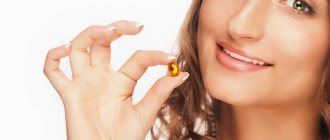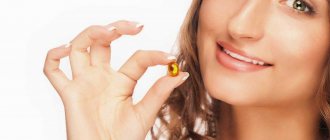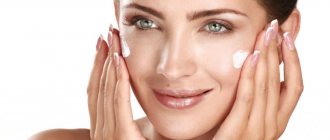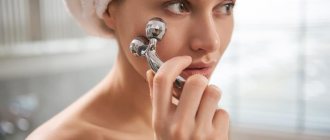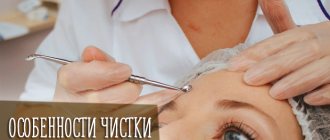Retinol is a chemical element, a smart riddle word, an advantage when choosing a cosmetic product for skin care. The presence of retinol in a beauty product scares some people away, while others, on the contrary, are attracted by a magnet. So what is retinol, why is it needed, should we be afraid of it or, on the contrary, should we boldly give it the main place in the skin care system for the face and body? How to use products with retinol correctly and what is their effectiveness? Our article is about one of the most popular ingredients in skin treatment and rejuvenation products.
Why are retinoids needed?
Retinoids perform 3 functions at once, which are in demand when lightening pigmentation:
- Lightening – see above;
- Antioxidant protection – reduce the number of free radicals that provoke melanin hyperproduction;
- Exfoliation – accelerates cellular turnover and removes stained skin cells.
Retinoids cope with all three tasks simultaneously, which reduces the number of products used to one.
Benefits of Retinol
- physiological - is a substance familiar to the skin, because the body itself supplies vitamin A to the skin in low concentrations;
- has no toxic effect;
- suppresses the increased activity of melanocytes, without destroying them, but normalizes melanin production;
- penetrates well into the skin, reaching the necessary layers;
- stimulates cellular renewal, preventing colored cells from remaining on the surface, and accelerates their exfoliation.
The principles of operation and benefits make retinoids the drugs of choice for correcting a number of skin problems: pigmentation, age-related changes, photoaging and acne.
Retinol, retinoids. Cosmetic care for correcting age-related skin changes
The main age-related factor in the appearance of wrinkles is a decrease in the production of collagen and elastin, which are responsible for the smoothness of the skin and complexion.
Retinoids are biologically active forms of vitamin A that accelerate the process of cell renewal in connective tissue. In cosmetology, they are used to reduce the manifestations of photoaging (age spots), acne, hyperkeratosis, and wrinkles.
They have proven their effectiveness as an anti-aging component. By stimulating cell renewal, they reduce the area and number of wrinkles, and also trigger the synthesis of collagen and elastin.
Retinoids are the general name for forms of retinol, substances, both synthetic and natural, which are similar in action to retinol itself and contain vitamin A, have a similar effect on cells due to their action on receptors for retinoic acid (RA).
Vitamin A derivatives are divided into four generations - the substances of the first (retinol, retinaldehyde, tretinoin) are the most effective, but at the same time they are the most aggressive. All synthetic retinoids are medicinal substances and are not allowed in cosmetics.
Retinol is the first vitamin to be discovered at the beginning of the 20th century, which is why it received the “name” of the first letter of the alphabet. Retinol is true vitamin A, it is retinoic acid.
It is synthesized in our body from products containing beta-carotene, is responsible for healthy skin and hair, good vision, bone growth and immunity, slows down aging and is involved in the formation of new cells and restoration of the skin, and fights inflammation. It is because of a lack of vitamin A in the body that immunity decreases, hair begins to break and split, nails begin to peel, and skin begins to peel.
Retinol is known for its ability to renew the skin and have a slight peeling effect, stimulating collagen synthesis in the skin. As a result, the stratum corneum softens and evens out, and the first signs of aging disappear.
There are quite a few forms of retinol; several are used in cosmetics:
for problem skin use retinal, retinoic acid and tretinoin; Anti-aging products often use retinol acetate or retinol palmitate.
The concentration of retinol in homemade anti-aging creams is usually no more than 0.1%. In more serious medicinal drugs - from 0.4% to 1%.
Benefits of retinol:
- smoothes wrinkles and creases (including deep ones);
- accelerates the process of cell formation and regeneration;
- evens out tone and relief;
- lightens age spots;
- protects against negative environmental factors (antioxidant);
- stimulates the production of collagen and elastin;
- moisturizes and retains moisture;
- increases skin turgor (elasticity);
- improves blood circulation;
- fights acne (suppresses the activity of the sebaceous glands);
- fights post-acne (as a chemical peeling).
How does retinol work?
Interestingly, it is not retinol itself that affects cells. First, it turns into an active form called retinoic acid, which is what affects the skin. Retinol itself is very unstable. When exposed to air, it instantly oxidizes and loses all its properties.
Therefore, using it in its pure form in a cosmetic product is problematic. Manufacturers have to find different ways to preserve the core functionality of a component. For example, use the least capricious forms. Retinol palmitate is considered one of the most effective.
It is placed in microcapsules or combined with stabilizing molecules. If you look at the composition, you can find a certain pattern: the more additional molecules “attached” to retinol, the longer the product will “survive” in the air. But there is also a minus: each new molecule makes vitamin A less active.
Retinol in cosmetics is considered an almost magical mixture, as it quickly solves many problems. Due to its low molecular weight, it easily penetrates the skin at the cellular level and affects the superficial and deeper layers of the epidermis.
Retinoids, due to their ability to regenerate the skin, are best used in the evening. And in the morning, be sure to apply a product with a high SPF to protect against ultraviolet radiation, because pigment spots can appear from solar radiation.
If you take a closer look at the composition of products aimed at solving various skin problems, you may find that retinol or retinoids can work either together or separately. In a duet they enhance each other's effect. Such combinations are used more often in anti-aging and whitening cosmetics, as well as in aesthetic procedures, for example, retinoic peeling.
Retinol is a capricious substance that does not like to be in second place and does not tolerate combination with acids and acne treatment components. Retinol and vitamin C do not combine so well that they even cancel each other out.
When combining drugs containing retinol and exfoliating components (glycolic, salicylic acid), keratalics or acne treatment components (antibiotics of the erythromycin class or benzoyl peroxide), you are guaranteed irritation.
Mild retinoids with caffeine are a great option for sensitive skin. With this duet they produce products for the area around the eyes, and this is the “most vulnerable” of all areas. Together they successfully fight dark circles under the eyes, fatigue and photoaging.
Trans-retinol (labeled “TR” on packaging) is a very serious type of retinol found in night serums. It successfully copes with wrinkles, increases the elasticity and density of the skin, and generally gives the face a fresh look.
The effectiveness of retinol decreases when there is too much of it.
It is better not to combine retinol in high concentrations with itself. It is possible to exceed the maximum percentage, which can even result in a chemical burn.
Retinol is “friendly” with components that enhance its positive effect on the skin (they can be classified as retinol-like): adenosine, jasmonic acid derivatives, vitamin E, tocopherol, which protects retinol from oxidation and is therefore found in almost all retinoid preparations.
Rules for the use of retinoids in cosmetic care:
- Gradual introduction of products with retinol and retinoids. If you plan to use cosmetics with a high concentration of vitamin A, then the course should begin with an adaptation period: first use the product 2 times a week, gradually increasing the frequency of use.
- It is imperative to use cosmetics containing retinol in courses to avoid side effects.
- Products containing retinol must be applied correctly. It is better to apply a cream containing vitamin A in a thin layer, as excess will oxidize, turning the skin a dirty yellow color. Retinoid cream is applied like all other cosmetics, unless otherwise stated in the instructions.
- It is necessary to apply products with SPF protection, face creams, and foundations before going outside. Retinol can increase skin sensitivity to ultraviolet radiation and pigmentation and inflammatory processes may appear on skin exposed to sunlight.
- In creams the concentration does not exceed 0.01–2%, but all skin types react to vitamin A differently. If the skin is thin and sensitive, it is better to start with a concentration no higher than 0.025%. If oily - with 0.5% (retinol can be drying and will slightly “slow down” the work of the sebaceous glands). Observe the skin reaction and gradually increase the dosage.
- Pay attention to additional components, because retinol does not work well with all components. For example, a duet with alpha hydroxy acids (AHAs) or salicylic acid will provoke severe redness and peeling. But benzoyl peroxide (may be in anti-acne products) deactivates retinol, and the product simply will not work. To minimize the negative effects of vitamin A, look for formulas with natural oils, green tea extract, vitamin C, ceramides, peptides and hyaluronic acid.
- As a rule, products with retinol are distributed by age categories: 35+, 45+, 55+, 60+. The main task of cream 35+ (retinol concentration from 0.1%) is anti-aging. Cream with retinol 45+ (concentration from 0.4 to 1%) fights signs of aging and evens out the appearance. And “after 50” products (concentration from 1%) are aimed at restoring and regenerating cells, smoothing out deep wrinkles and creases, and synthesis of collagen and elastin.
- The texture of the product matters. Choose a product based on your skin type.
- Since the active forms of vitamin A are unstable and are destroyed when exposed to sunlight, packaging and bottle are very important when choosing a product with retinol. An opaque tube or bottle is ideal.
The main contraindication is the presence of cancer. Pregnant and breastfeeding women should also not use products containing retinoids. Of course, preparations with high concentrations of vitamin A cannot be bought in stores - they are sold in pharmacies. However, it is better to consult a cosmetologist rather than prescribe retinol yourself.
Martinex peelings.
The mechanism of action of retinoic peels is fundamentally different from the mechanism of action of other chemical peels.
Retinoids do not damage the skin and do not coagulate proteins. By interacting with their own nuclear receptors of basal keratinocytes, melanocytes and fibroblasts, retinoids:
- increase the level of mitotic activity of basal keratinocytes;
- normalize the processes of differentiation and keratinization in the epidermis;
- stimulate the synthesis of epidermal lipids;
- activate the synthesis of components of the intercellular matrix of the dermis;
- normalize melanin synthesis;
- reduce the number of atypical cells.
As a result, the appearance of age-related skin changes of various etiologies slows down, pigmentation decreases, and skin texture and relief improves. Referring to superficial peels in terms of penetration depth, according to the results obtained, the BLOCK AGE PEEL CREAM peeling from the Medic Control Peel line is comparable to medium-impact peels, such as 25% trichloroacetic peel. Histological studies have shown that the stimulating effect on the cellular structures of the skin persists for another 4 months after the last application of retinoids. The formulation of the drug includes retinoic acid at a concentration of 5%, which ensures high performance of BLOCK AGE PEEL CREAM. The glycolic, phytic and ascorbic acids included in the composition also complement the action of retinoids and ensure maximum results and comfort of the procedure.
BLOCK AGE PEEL GEL - chemical peeling based on retinoic acid 5%.
It has all the advantages of drugs in this group: a complex effect on the skin and high effectiveness, which is combined with an atraumatic procedure and a short rehabilitation period. As a result of the procedure, skin aging slows down, a pronounced rejuvenating and brightening effect is provided, and the texture and relief of the skin improves.
Release form:
Phase No. 1 (2.7 ml) - 5 pcs.
Phase No. 2 (2.3 ml) - 5 pcs.
Packed in a cardboard case. For one peeling procedure, two bottles are used (phase No. 1 and phase No. 2), the contents of which are thoroughly mixed before use.
A unique feature of Block Age Peel Gel is dimethyl sulfoxide (50%), which is part of the drug, which significantly increases the permeability of all cell membranes to retinoic acid, which ensures maximum effectiveness of the procedure.
Also, dimethyl sulfoxide (Dimexide) improves metabolic processes and has a moderate local anesthetic and antimicrobial effect.
BLOCK AGE PEEL CREAM - peeling with 5% retinoic acid.
Release form: Dispenser 30 ml
It copes well with the aesthetic correction of small facial defects: wrinkles, pigment spots, post-traumatic, post-operative scars, scars after previous acne. Let's compare with medium-impact peels, such as 25% trichloroacetic peel.
The glycolic, phytic and ascorbic acids included in the product complement the action of retinoic acid and ensure maximum results and comfort of the procedure.
The complex effect of the drug on the skin and the high effectiveness of the procedure are combined with its non-traumatic nature and short rehabilitation period.
Histological studies have shown that the stimulating effect on the cellular structures of the skin persists for another 4 months after the last application of retinoids.
Proper preparation for the chemical peel procedure, as well as the use of the necessary medications during the recovery period, are extremely important to achieve the best results from the peeling procedure.
THRIPHILANBALM
Release form: Dispenser 30 ml
A restorative anti-inflammatory balm for damaged skin. It is used immediately after the procedure of chemical peeling, laser resurfacing, microdermabrasion and until the completion of the rehabilitation period.
- Quickly and completely restores damaged skin
- Normalizes regenerative processes and has a wound healing effect
- Has anti-inflammatory and bactericidal effects
- Intensely nourishes, prevents dehydration
- Eliminates erythema, symptoms of irritation and dryness, feeling of tightness
- Restores the skin's natural immunity
- Has an antioxidant effect
- Protects skin from adverse environmental factors
Active Ingredients:
- Shea Butter
- Rapeseed oil
- Coconut oil
- Tamanu oil
- Jojoba oil
- Chamomile and calendula extracts
- Retinol,
- Vitamins C and E
Directions for use: Apply to skin daily 2 times a day or more often.
Release form: Tube 50 ml
Prepeel Active cream is intended for regular care of aging skin with signs of premature aging and hyperpigmentation.
It is also ideal as a preparatory agent for chemical peeling procedures, laser resurfacing, and photo procedures.
General action:
- reduces and smoothes the stratum corneum
- normalizes pigment synthesis, reduces the risk of post-peeling hyperpigmentation
- stimulates the regenerative processes of skin cells
- increases local skin immunity
Active Ingredients:
retinol (vitamin A) - stimulates cellular renewal processes, providing a general rejuvenating effect, helps restore and strengthen epithelial cells. Promotes rapid renewal of the epidermis, reduces pigmentation and improves collagen synthesis, normalizes the function of the follicular epithelium, and has a sebum-regulating effect
Vitamin E is a powerful antioxidant, slows down the aging process, has an anti-inflammatory effect, and actively heals skin damage. Refreshes the skin, restores its water balance, protects against the harmful effects of UV rays and acts as a natural preservative.
Vitamin C is a powerful antioxidant that refreshes and rejuvenates the skin, evens out complexion and reduces pigmentation. Soothes sensitive skin prone to irritation and inflammation
Milk proteins are active protein complexes that have strong softening, regenerating, moisturizing, anti-allergenic and anti-inflammatory properties.
Angustifolia fireweed extract - has an anti-inflammatory effect, stimulates metabolic processes, and is a powerful antioxidant
Rapeseed oil – contains vitamin E, which protects the skin from damage caused by the external environment
VEGELIP
Format: tube 50/200 ml
A universal product for the care and protection of skin with a damaged barrier. Ideal for irritated and damaged skin. The active ingredients of the cream promote rapid regeneration, deep intensive hydration and restoration of the skin, including after aggressive procedures (after peeling, laser therapy and microdermabrasion). The cream has an antioxidant effect, stimulates cellular regeneration, and reduces wrinkles.
Active components:
- German sesame oil,
- retinol,
- vitamins E and C
- natural moisturizing complex
SEMTEMPOCREAM
Format: tube 50ml
ANTI-AGING CREAM
Complex cream for the correction of wrinkles and hyperpigmentation. Recommended for maintaining the results of chemical peels.
- Eliminates fine wrinkles
- Slows down the skin aging process
- Increases skin tone and turgor
- Stimulates the synthesis of your own collagen
- Normalizes melanin synthesis, brightens the skin
- Provides optimal levels of skin hydration
- Neutralizes free radicals
- Accelerates cellular renewal processes
Active Ingredients:
- Natural Moisturizing Complex (NaPCA)
- Phytic acid
- Milk protein
- Bearberry and green tea extracts
- Neutrazen TM (Palmitoyl tripeptide-8)
- Retinol,
- vitamins C and E
Directions for use: Apply cream to dry, clean skin 1-2 times a day. To maintain the results of chemical peeling, the cream is applied daily (according to a certain scheme).
FOR PURCHASE QUESTIONS, CONTACT THE MANAGERS OF THE TRAINING AND CONSULTING CENTER
Educational phone numbers : 8-812-248-99-34, 8-812-248-99-38, 8-812-243-91-63, 8-929-105-68-44
Application for ordering products here
Seminar schedule here
Application of retinol
How does retinol work and what is it? Due to their unique properties, vitamin A derivatives are used not only for cosmetic purposes, but also in pharmacology, having a great impact on supporting the normal functioning of the body. Let's look at where they are found, what benefits they provide and how to properly use cosmetics based on them.
In cosmetics
At the heart of corrective care formulas at home, retinoids are responsible for the accelerated regeneration of epidermal cells, improve skin tone, texture and texture, suppress the breakdown of natural collagen after the 25th birthday, help fight premature wrinkles and dryness, increase skin turgor, and lighten age spots , fight photoaging.
Also, due to its keratolytic properties, retinol is used as the basis of care for oily problem skin types prone to thickening and acne. The component stabilizes the functioning of the sebaceous glands, reduces enlarged pores, controls sebum regulation and prevents inflammation.
In cosmetology
Aesthetic treatments based on retinoids are very popular. Many of them are aimed at rejuvenation and activate cellular renewal. For example, retinol peels correct visible age-related changes in the skin and the consequences of excessive sun exposure (photoaging): loss of skin firmness and elasticity, hyperpigmentation, wrinkles, dull color and uneven skin texture. Such peelings are carried out in the cold season (autumn-winter), during periods of reduced solar activity. Retinol is also used in therapy for the treatment of acne, acne, post-acne (evens out scars and congestive spots), reduces pores and controls sebum production. It is recommended to use masks with retinol 1-2 times a week.
In pharmaceuticals
In pharmacology, the most common form is considered to be a retinol solution. The product is responsible for maintaining the normal condition of the skin and mucous membranes, plays an important role in mineral metabolism, and accelerates the processes of cell division. It also takes part in the redox processes of the body, promotes the synthesis of essential proteins and lipids.
The effect of retinol on the skin
Retinol can be beneficial for almost everyone. “Retinoids are keratolytics,” says Sheila Farhang. “This means they stimulate cell turnover and collagen synthesis.” Experts recommend including products with retinol in your care if you want to slow down skin aging. “These products will help reduce the appearance of wrinkles and help smooth and firm your skin,” says Ron Robinson.
Retinol is also useful for problem skin. “Rapid cell turnover will help unclog pores and combat acne,” says Sheila Farhang. — And also get rid of redness and pigmentation after acne. Collagen synthesis will make acne scars less noticeable. Stronger prescription retinoids are used to treat acne. Over-the-counter formulas are designed to care for skin showing signs of aging.”
FAQ:
Dermatologist Alexander Prokofiev, an expert of the La Roche-Posay brand, answers the questions.
Is retinol acceptable in cosmetics during pregnancy or breastfeeding?
Cosmetics with retinol are contraindicated for pregnant and breastfeeding women. In high concentrations, the component can be toxic and accumulates in the body and can negatively affect the formation of the embryo, therefore it is recommended to plan pregnancy no earlier than six months after the end of the course of care.
Retinol in cosmetics: how is it designated?
In the basis of cosmetic formulas, derivative forms of vitamin A appear as Differin (adapelene), Retin-A, Renova (tretinoin), Retinoic acid (retinoic acid), Retinol (retinol), Retinyl linoleate (retinol linoleate), Retinyl palmitate (retinol palmitate).
